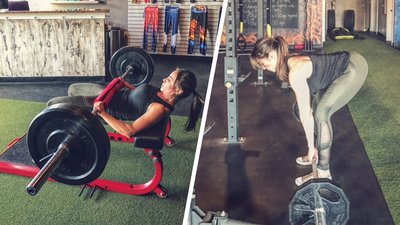Standing onstage, competing in nothing more than a two-piece swimsuit and high heels, there's no way to hide. Your rear view must be flawless.
Former IFBB fitness pro Carla Sanchez understands this better than most. The owner of Performance Ready Fitness Studio, Sanchez has trained hundreds of aspiring amateur and professional fitness, figure, and bikini athletes in the fine art of a perfect backside.
Here are four must-have moves in her glute-sculpting arsenal, as well as advice on troubleshooting each one for maximum effectiveness.
1. Romanian Deadlift
The move: For incredible shape and definition in your glutes and hamstrings, Sanchez says there's one motion to master above all others: the hip hinge. To perform the hinge, push your hips backward while keeping your back straight, and bend slightly at the knees with your shins remaining vertical—a movement pattern also known as the Romanian deadlift.

The problem: Most struggle with the nuance of a Romanian deadlift. People tend to bend their knees too much or round their lower back, transferring the stress from the target muscles of the posterior chain to the injury-susceptible lumbar area.
Sanchez's pointers:
- A Romanian deadlift is not a squat, which involves maximum knee and hip bend. Here, it's all about hip hinging, which is maximum hip bend with minimal knee bend.
- Take a narrower stance than you would a squat, with your feet inside shoulder width, but not together. Point your feet and knees forward and take an overhand grip on the bar with both hands.
- Keep the bar close to your thighs as you hinge. You should feel a stretch through your hamstrings when you lower the bar. Squeeze your glutes strongly at the top of the movement.
- Never round your back. If your back starts to round, stop your range of motion there. Work on your flexibility with the goal to eventually bring the bar down to a point where the weight plates are less than an inch from the floor.
Also consider: The Romanian deadlift can also be performed with dumbbells or kettlebells.
2. Cable Pull-Through
The move: A close cousin of the Romanian deadlift, this movement shifts the angle of pull and maintains continuous tension throughout the range of motion.

The problem: As before, mastering the hip hinge is a challenge, especially for those who lack adequate flexibility through their glutes, hamstrings, and calves, not allowing them to keep the balls of their feet to the floor.
Sanchez's pointers:
- Take a wide stance facing away from the cable machine—slightly wider than shoulder width.
- Straddle a rope attachment and grasp one side of the rope firmly in each hand, thumb side pressed against the end-knot in the rope. Take a few steps away from the weight stack so you can get a full range of motion, without the stack touching down between reps. Don't be afraid to reposition to get it right.
- As you hip hinge, reach through your legs so your hands go past your knees, while keeping your back flat to align your head with your spine.
- Contract through your glutes to initiate the motion of the hinge and bring your upper body upright.
- Do not pull the rope with your upper body—focus on your glutes doing the work, squeezing them at the top of the movement.
Also consider: Flexibility is crucial for a proper pull-through, so stretch between sets. Also, consider adding at least five minutes of static leg stretches at the end of every lower-body training session, focusing attention on both your quads and hamstrings.
3. Kettlebell Swing
The move: A stalwart among functional exercise enthusiasts, the kettlebell swing engages numerous muscles synergistically in one dynamic, explosive motion.

The problem: "Dynamic" and "explosive" can quickly turn sloppy if you don't control your form.
"I see this exercise performed incorrectly all the time," Sanchez admits. "The power of the movement comes from the hips and hits the glutes and hamstrings beautifully, when executed correctly."
Sanchez's pointers:
- Stand about a foot length behind the kettlebell, your feet set a little wider than hip-width apart. Too narrow a stance and you lose your base of power.
- Hold the handle of the kettlebell with both hands, wrapping your thumbs around it. Don't get careless with your grip, for obvious reasons.
- Start the movement slowly, building your way up to a full swing. Begin by swinging the bell back through your legs, past your knees, to generate momentum.
- As you swing the kettlebell forward, do not use your shoulders to lift the weight—instead, use your hips to thrust it forward and upward.
- Squeeze your glutes at the top of the movement. Thinking about this on each rep ensures your mind is on the muscle you're working and keeps them fully engaged.
- The heavier the load, the better—but you must work your way up to it. Don't ever sacrifice perfect form for a heavier weight.
Also consider: A variation of the kettlebell swing involves alternating the hand that you hold the kettlebell with, instead of holding the bell with both hands, switching from one hand to the other at the top of the motion. This variation slightly shifts the stimulus, but demands more coordination.
4. Lying Barbell Hip Thrust
The move: Lie with your upper back resting on a bench, or on the floor, with a loaded barbell over your hips. Press through your feet to lift your pelvis straight up against the resistance, contracting your glutes through the motion.

The problem: It's hard to balance the barbell while still maintaining proper form from your feet to your shoulders.
Sanchez's pointers:
- Beginners should get their form down with only the barbell, then set a goal of working up to a barbell loaded with two times their bodyweight for 3 sets of 10-15 reps.
- Position the barbell on your lap so it lays across your lower abs, just above the pubic bone, then move the barbell up or down a bit to find the most comfortable placement. For added comfort, wrap a mat around the barbell or use a Squat Sponge.
- Place your feet a little wider than hip width and plant them firmly on the floor. Keep your neck and spine in a neutral position, with your upper back in firm contact with the bench.
- This motion happens directly at the hip joint—you contract your glutes to lift your hips off the floor and hold at the top for 1-3 seconds, then return under control.
Also consider: This movement can be performed on a Reebok step with 2-4 risers, or using the specially designed Hip Thruster. You can also use dumbbells instead of a barbell, or try a single-leg hip thrust with just body weight.
For the latter, lift one leg off the floor and keep it elevated while the other foot remains planted firmly on the floor as you extend that hip, contracting your glute. Hold for 1-3 seconds at the top before lowering under control.

